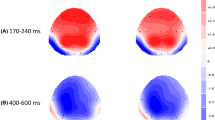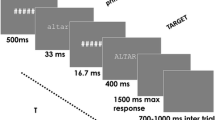Abstract
The electroencephalogram (EEG)-based N400 component is often described as an index of a semantic relation. Recent studies suggested that the N400 component can also be used as an electrophysiological measure of equivalence class formation, yet more research is needed to clarify the effects of experimental conditions on the N400 response. In Experiment 1 of the present study, the participants were trained on six conditional discriminations and tested for the formation of three 3-member classes. If they formed equivalence classes with half of the possible emerged relations, the participants were given a priming test with the other half. Related and unrelated stimulus pairs were presented, and the participant had to decide whether the stimuli were related or not. The results showed that a nonsignificant N400 response was observed after unrelated stimulus pairs were presented but not when related stimulus pairs were presented. The strength of the N400 response weakened over the number of stimuli presentations. In Experiment 2, we examined whether changes to the methodology of Experiment 1 would produce stronger N400 responses. The participants also underwent a word priming procedure, which has been shown to produce robust N400 responses. We found more robust N400 responses in Experiment 2 than in Experiment 1, and the N400 response was larger in transitivity/equivalence relations than in symmetry relations. There was also a significant relation effect in the word priming procedure. Together, these findings support the notion that the N400 component can be used as an electrophysiological measure of equivalence class formation and illustrate how experimental conditions can influence the N400 response.







Similar content being viewed by others
References
Arntzen, E. (2004). Probability of equivalence formation: Familiar stimuli and training sequence. The Psychological Record, 54(2), 275–291. https://doi.org/10.1007/BF03395474.
Arntzen, E. (2006). Delayed matching to sample: Probability of responding in accord with equivalence as a function of different delays. Psychological Record, 56(1), 135–167. https://doi.org/10.1007/BF03395541.
Arntzen, E. (2012). Training and testing parameters in formation of stimulus equivalence: Methodological issues. European Journal of Behavior Analysis, 13, 123–135. https://doi.org/10.1080/15021149.2012.11434412.
Arntzen, E., Grondahl, T., & Eilifsen, C. (2010). The effects of different training structures in the establishment of conditional discriminations and subsequent performance on tests for stimulus equivalence. The Psychological Record, 60(3), 437–461. https://doi.org/10.1007/BF03395720.
Arntzen, E., & Hansen, S. (2011). Training structures and the formation of equivalence classes. European Journal of Behavior Analysis, 12(2), 483–503. https://doi.org/10.1080/15021149.2011.11434397.
Arntzen, E., & Holth, P. (1997). Probability of stimulus equivalence as a function of training design. The Psychological Record, 47(2), 309–320. https://doi.org/10.1007/BF03395227.
Azizian, A., Watson, T. D., Parvaz, M. A., & Squires, N. K. (2006). Time course of processes underlying picture and word evaluation: An event-related potential approach. Brain Topography, 18(3), 213–222.
Barnes-Holmes, D., Staunton, C., Whelan, R., Barnes-Holmes, Y., Commins, S., Walsh, D., . . . Dymond, S. (2005). Derived stimulus relations, semantic priming, and event-related potentials: Testing a behavioral theory of semantic networks. Journal of the Experimental Analysis of Behavior, 84(3), 417–433. https://doi.org/10.1901/jeab.2005.78-04
Bigdely-Shamlo, N., Mullen, T., Kothe, C., Su, K.-M., & Robbins, K. A. (2015). The PREP pipeline: Standardized preprocessing for large-scale EEG analysis. Frontiers in Neuroinformatics, 9. https://doi.org/10.3389/fninf.2015.00016.
Bortoloti, R., & de Rose, J. C. (2009). Assessment of the relatedness of equivalent stimuli through a semantic differential. The Psychological Record, 59(4), 563–590. https://doi.org/10.1007/BF03395682.
Bortoloti, R., & de Rose, J. C. (2012). Equivalent stimuli are more strongly related after training with delayed matching than after simultaneous matching: A study using the Implicit Relational Assessment Procedure (IRAP). The Psychological Record, 62(1), 41–54. https://doi.org/10.1007/BF03395785.
Bortoloti, R., Pimentel, N., & de Rose, J. C. (2014). Electrophysiological investigation of the functional overlap between semantic and equivalence relations. Psychology & Neuroscience, 7(2), 183–191. https://doi.org/10.3922/j.psns.2014.015.
Chaumon, M., Bishop, D. V. M., & Busch, N. A. (2015). A practical guide to the selection of independent components of the electroencephalogram for artifact correction. Journal of Neuroscience Methods, 250, 47–63. https://doi.org/10.1016/j.jneumeth.2015.02.025.
Delmore, A., & Makeid, S. (2004). EEGLAB: An open source toolbox for analysis of single-trial EEG dynamics including independent component analysis. Journal of Neuroscience Methods, 134, 9–21. https://doi.org/10.1016/j.jneumeth.2003.10.009.
Delorme, A., Palmer, J., Onton, J., Oostenveld, R., & Makeig, S. (2012). Independent EEG sources are dipolar. PLoS One, 7(2). https://doi.org/10.1371/journal.pone.0030135.
Donahoe, J. W., & Palmer, D. C. (1994). Learning and complex behavior. Needham Heights, MA: Allyn & Bacon.
Duncan, C. C., Barry, R. J., Connolly, J. F., Fischer, C., Michie, P. T., Näätänen, R., . . . Van Petten, C. (2009). Event-related potentials in clinical research: Guidelines for eliciting, recording, and quantifying mismatch negativity, P300, and N400. Clinical Neurophysiology, 120(11), 1883–1908. doi:https://doi.org/10.1016/j.clinph.2009.07.045
Fields, L., Arntzen, E., Nartey, R. K., & Eilifsen, C. (2012). Effects of a meaningful, a discriminative, and a meaningless stimulus on equivalence class formation. Journal of the Experimental Analysis of Behavior, 97(2), 163–181. https://doi.org/10.1901/jeab.2012.97-163.
Fields, L., Hobbie, S. A., Adams, B. J., & Reeve, K. F. (1999). Effects of training directionality and class size on equivalence class formation by adults. The Psychological Record, 49(4), 703–723. https://doi.org/10.1007/BF03395336.
Haimson, B., Wilkinson, K. M., Rosenquist, C., Ouimet, C., & McIlvane, W. J. (2009). Electrophysiological correlates of stimulus equivalence processes. Journal of the Experimental Analysis of Behavior, 92(2), 245–256. https://doi.org/10.1901/jeab.2009.92-245.
Horne, P. J., & Lowe, C. F. (1996). On the origins of naming and other symbolic behavior. Journal of the Experimental Analysis of Behavior, 65(1), 185–241. https://doi.org/10.1901/jeab.1996.65-185.
Kielar, A., & Joanisse, M. F. (2010). Graded effects of regularity in language revealed by N400 indices of morphological priming. Journal of Cognitive Neuroscience, 22(7), 1373–1398.
Klee, T., Marr, C., Robertson, E., & Harrison, C. (1999). MacArthur Communicative Development Inventory: Words and sentences (British English adaptation).
Kutas, M., & Federmeier, K. D. (2011). Thirty years and counting: Finding meaning in the N400 component of the event related brain potential (ERP). Annual Review of Psychology, 62, 621–647. https://doi.org/10.1146/annurev.psych.093008.131123.
Kutas, M., & Hillyard, S. (1980). Reading senseless sentences: Brain potentials reflect semantic incongruity. Science, 207(4427), 203–205.
Luck, S. J. (2014). An introduction to the potential event-related technique. Cambridge, MA: MIT Press.
Menéndez, J., Sánchez, F., Polti, I., Idesis, S., Avellaneda, M., Tabullo, Á., & Iorio, A. (2018). Event-related potential correlates of stimulus equivalence classes: A study of task order of the equivalence based priming probes with respect to the stimulus equivalence tests, and among the distinct trial types with each other. Behavioral Brain Sciences, 347. Advance online publication. https://doi.org/10.1016/j.bbr.2018.03.017
Miguel, C. F. (2016). Common and intraverbal bidirectional naming. Analysis of Verbal Behavior, 32(2), 125–138. https://doi.org/10.1007/s40616-016-0066-2.
Neely, J. H. (1991). Semantic priming effects in visual word recognition: A selective review of current findings and theories. In D. Besner & G. W. Humphreys (Eds.), Basic processes in reading: Visual word recognition (pp. 264–336). Hillsdale, NJ: Lawrence Erlbaum Associates.
Nolan, H., Whelan, R., & Reilly, R. (2010). FASTER: Fully automated statistical thresholding for EEG artifact rejection. Journal of Neuroscience Methods, 192(1), 152–162. https://doi.org/10.1016/j.jneumeth.2010.07.015.
Ortu, D. (2012). Neuroscientific measures of covert behavior. The Behavior Analyst, 35(1), 75–87. https://doi.org/10.1007/BF03392267.
Ortu, D., Allan, K., & Donaldson, D. I. (2013). Is the N400 effect a neurophysiological index of associative relationships? Neuropsychologia, 51(9), 1742–1748. https://doi.org/10.1016/j.neuropsychologia.2013.05.003.
Sidman, M. (1994). Equivalence relations and behavior: A research story. Boston, MA: Authors Cooperative.
Sidman, M., & Tailby, W. (1982). Conditional discrimination vs. matching to sample: An expansion of the testing paradigm. Journal of the Experimental Analysis of Behavior, 37(1), 5–22. https://doi.org/10.1901/jeab.1982.37-5.
Stromer, R., & Mackay, H. (1996). Naming and the formtation of stimulus classes. In T. R. Zentall & H. A. Smeets (Eds.), Stimulus class foration in humans and animals (pp. 221–252). Amsterdam, The Netherlands: Elsevier.
Tabullo, A., Yorio, A., Zanutto, S., & Wainselboim, A. (2015a). An ERP comparison of derived relations in stimulus equivalence classes. Psychology & Neuroscience, 8(4), 509–528. https://doi.org/10.1037/pne0000028.
Tabullo, A., Yorio, A., Zanutto, S., & Wainselboim, A. (2015b). ERP correlates of priming in language and stimulus equivalence: Evidence of similar N400 effects in absence of semantic content. International Journal of Psychophysiology, 96(2), 74–83. https://doi.org/10.1016/j.ijpsycho.2015.03.004.
Vaidya, M., & Smith, K. N. (2006). Delayed matching-to-sample training facilitates derived relational responding. Experimental Analysis of Human Behavior Bulletin, 24, 9–16.
von Koss Torkildsen, J., Syversen, G., Simonsen, H. G., Moen, I., & Lindgren, M. (2007). Electrophysiological correlates of auditory semantic priming in 24-month-olds. Journal of Neurolinguistics, 20(4), 332–351.
Wang, T., & Dymond, S. (2013). Event-related potential correlates of emergent inference in human arbitrary relational learning. Behavioral and Brain Sciences, 236, 332–343.
Widmann, A., Schröger, E., & Maess, B. (2015). Digital filter design for electrophysiological data: A practical approach. Journal of Neuroscience Methods, 250, 34–46. https://doi.org/10.1016/j.jneumeth.2014.08.002.
Yorio, A., Tabullo, Á., Wainselboim, A., Barttfeld, P., & Segura, E. (2008). Event-related potential correlates of perceptual and functional categories: Comparison between stimuli matching by identity and equivalence. Neuroscience Letters, 443(3), 113–118. https://doi.org/10.1016/j.neulet.2008.07.001.
Funding
This study was funded by the South-Eastern Norway Regional Health Authority, Oslo University Hospital, Akershus University Hospital, Oslo Metropolitan University, the Ebbe Frøland foundation, and a research grant from Mrs. Throne-Holst.
Author information
Authors and Affiliations
Corresponding author
Ethics declarations
Conflicts of interest
The authors declare that there is no conflict of interest.
Ethics approval
All procedures performed in studies involving human participants were in accordance with the ethical standards of the institutional research committee and with the 1964 Helsinki declaration and its later amendments or comparable ethical standards. The project is approved by Regional Committees for Medical and Health Research Ethics (2016/629)
Informed Consent
Informed consent was obtained from all individual participants included in the study.
Additional information
Publisher’s Note
Springer Nature remains neutral with regard to jurisdictional claims in published maps and institutional affiliations.
Rights and permissions
About this article
Cite this article
Granerud-Dunvoll, G., Arntzen, E., Elvsåshagen, T. et al. Equivalence Class Formation and the N400: Methodological Issues. Psychol Rec 69, 175–191 (2019). https://doi.org/10.1007/s40732-019-00332-x
Published:
Issue Date:
DOI: https://doi.org/10.1007/s40732-019-00332-x




